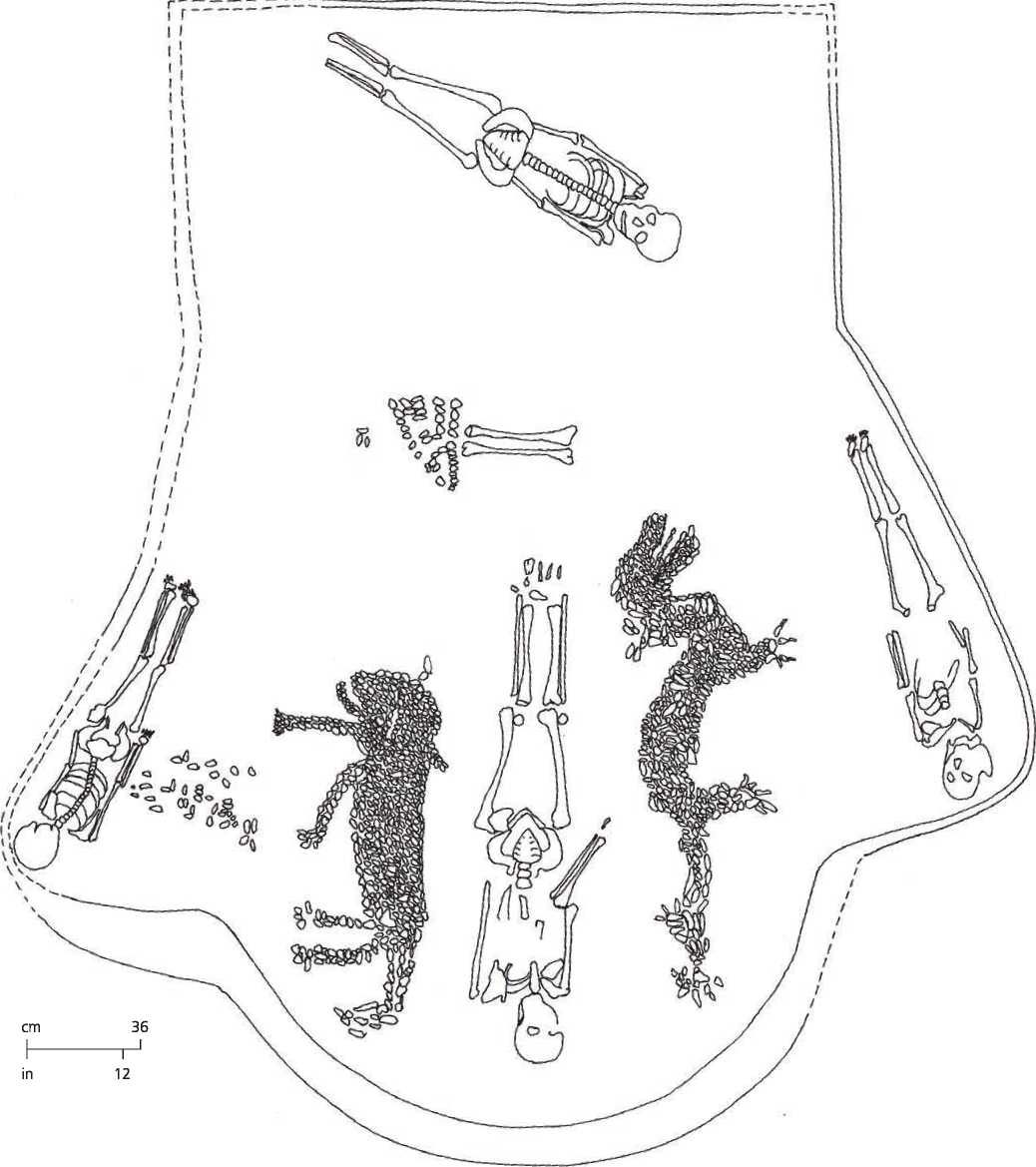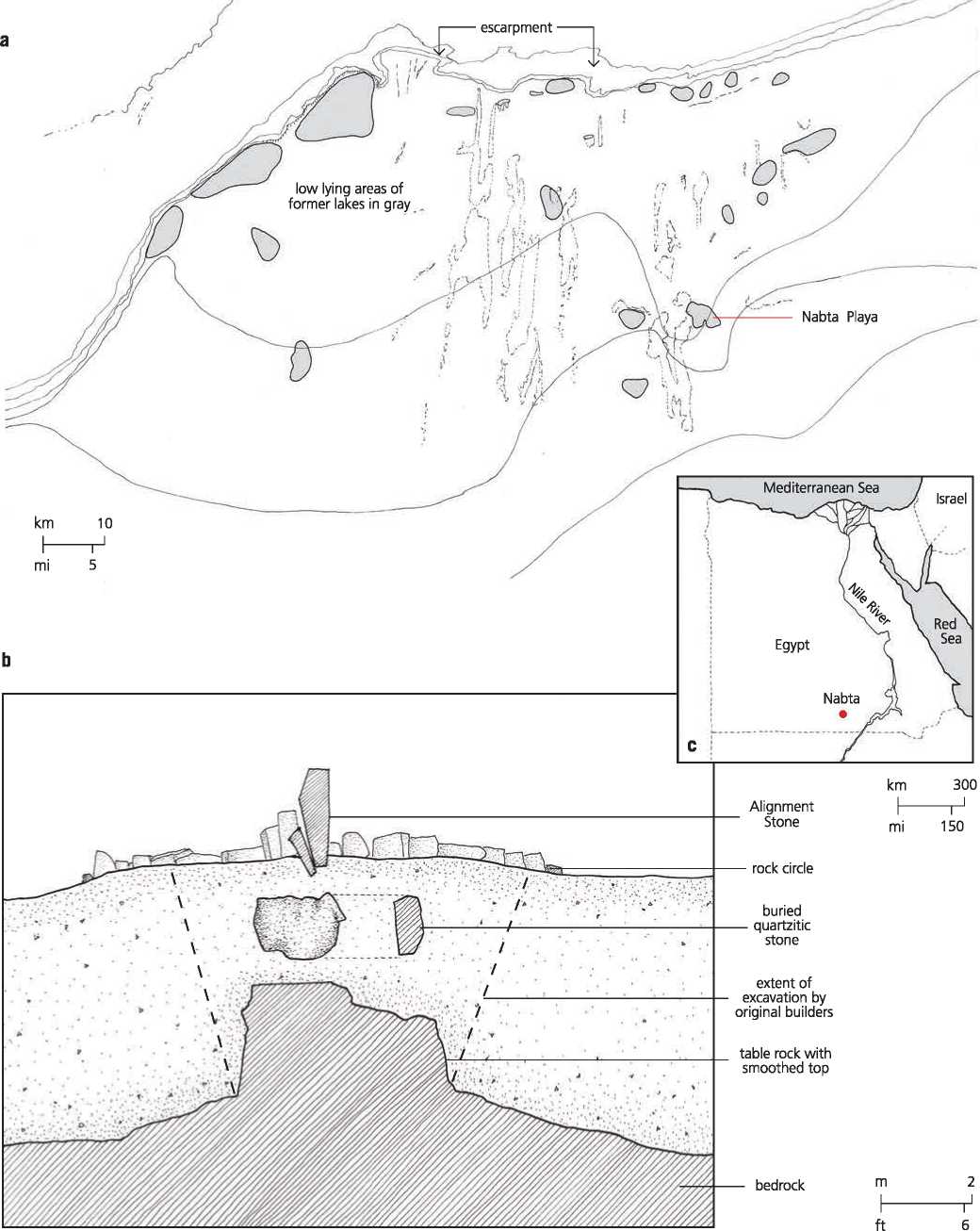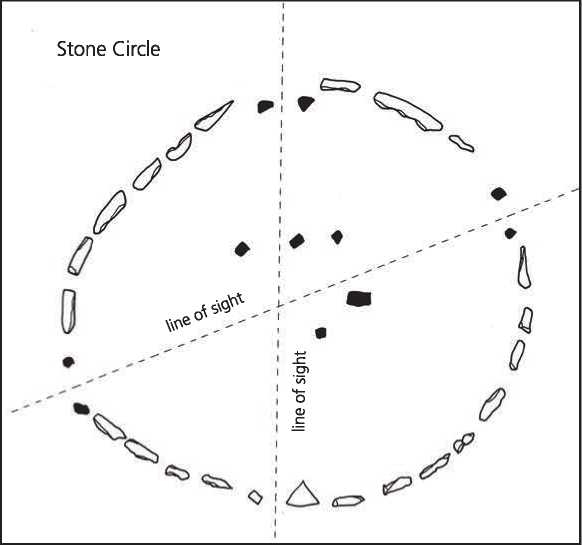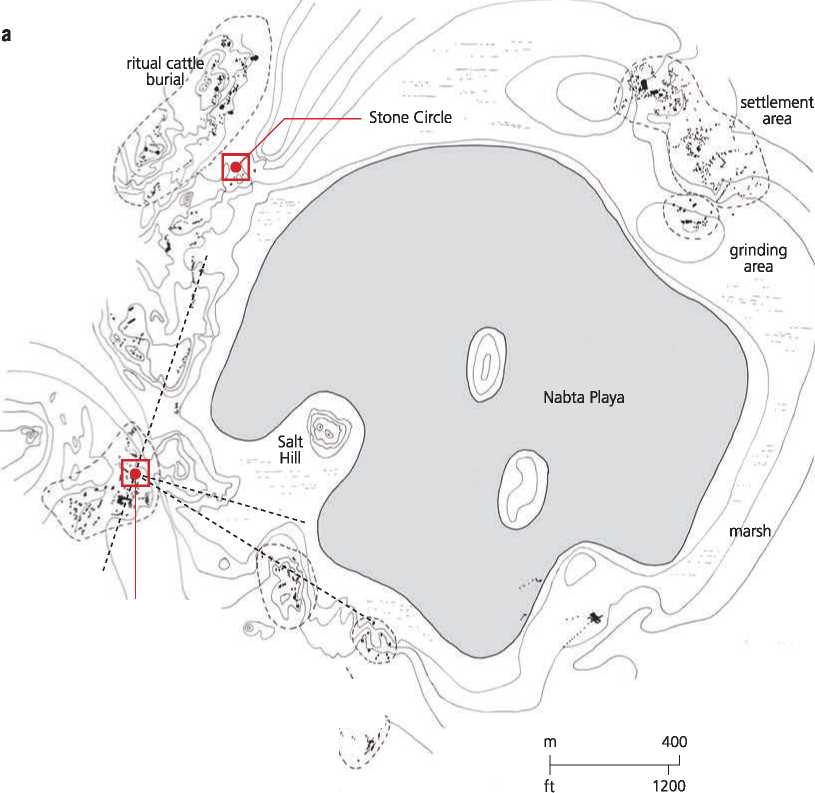It was once thought that Stonehenge, which dates to about 3000 bce, was the oldest ritual center in the world. As it turns out, it was probably one of the last in a long line of such centers. A 1

Figure 7.34: Tomb of shaman priest. Source: Timothy Cooke/Li Lui and Xingcan Chen, The Archaeology of China From the Late Paleolithic to the Early Bronze Age (Cambridge: Cambridge University Press, 2012), 197
(Figures 7.35a, 7.35b and 7.36a, 7.36b). Originally, the area was next to a large lake—one of several—with broad, swampy shores suitable for the great herds of pasturing animals. And this area was itself just part of a vast herding zone that stretched perhaps as far north into the 25th parallel. A settlement was located on the northern shore that consisted of a dozen or so huts, in front of which, at a site where grinding stones were found, there was a common area for the preparation of grain and ochre.

Figure 7.35a, b, c: Nabta Playa, Egypt: (a) map of Kiseiba-Nabta area; (b) section through alignment stone; (c) map. Source: Timothy Cooke/Fred Wendorf and Halina Kroiik, "Site E-96-1: The Compiex Structures or Shrines," in Hoiocene Settiement of the Egyptian Sahara, Voiume 1: The Archaeoi-ogy of Nabta Piaya, eds. Fred Wendorf and Romuaid Schiid (New York: Kiuwer Academic, 2001), 503-520
The huts varied in size. One hut, 9 meters long and 4 wide, had five hearths across the central part of it. The floor was dug out in the sandy soil and built out of the tamarisk branches placed in the ground and covered with reed mats. The hearths were surrounded by various-sized shallow pits that held ceramic pots for water or for cooking. Artifacts recovered from the floors showed that the occupants were not only making the usual flint tools, but were also carving bits of ostrich eggshells into necklaces. The surface of the shells was decorated with patterns and lines. The ritual significance of these necklaces is not known. A second style of hut was developed that was circular in plan with an attached entrance tunnel. The hut was partially sunken into the ground about 20 centimeters similar to the pit-house type. The Himba people who inhabit northern Namibia and who migrated there from parts unknown with their cattle culture many centuries ago still build huts of very similar dimension.


Figure 7.36a, b: Nabta Playa, Egypt; (a) site plan; (b) detail of the calendar circle. Source: Timothy Cooke/Fred Wendorf and Halina Krolik, "Site E-96-1: The Complex Structures or Shrines,” in Holocene Settlement of the Egyptian Sahara, Volume 1: The Archaeology of Nabta Playa, eds. Fred Wendorf and Romuald Schild (New York: Kluwer Academic, 2001), 503-520
Alignment
Stone
Across the lake, on the western shore was an area dedicated to cattle burials. Nearby was a circle of slender upright stones, consisting of four pairs set close together. It seems to date to about 4000 bce, about a thousand years before Stonehenge.32 The circle, situated on the crest of a ridge, near the lake shore, is small, measuring roughly 4 meters in diameter, but its purpose was similar to that of Stonehenge, namely to organize time according to the seasons. Two of the stone pairs were aligned along the true north-south axis and, with two others aligned on the northeast-southwest axis, helped observe the motion of the sun and the Orion constellation. Establishing the solstice helped to predict the summer rains that would begin soon after.
To the south of the calendar circle, there is an extensive array of stone circles including a set of alignments, pointing in the northerly and southeasterly direction. At the origin point of these alignments, archaeologists made an astonishing discovery. The origin stone was framed by an oval field of stones about 5 meters across. Beneath this was not a burial, as the archaeologists expected, but a large stone with an unusual shape. About a meter and a half around, but about 30 centimeters thick, it had one side that was flat and another that was slightly convex. It also had a projection resembling the head of a cow. And indeed the stone was buried in the sand, standing upright and facing north. As it turns out the stone was placed about 40 centimeters over the top of a table rock. The desert in this area is filled with these small rock towers, or “tables,” but this one was buried 2 meters in the sand and thus invisible from the surface. This means that the ancient builders somehow managed to locate this hidden geological event. Then they dug out a rather sizable hole to get access to it. They then smoothed the top of the table rock and even reshaped its sides using stone mallets. Then they covered it up, burying the “cow” stone just above the table rock as they filled in the hole. When this was finished, they constructed the oval mound with the projecting center stone. Needless to say this required a huge effort and the fact that the top of the table rock and even the “cow stone” were worked shows that stone carving was already a developed skill. But the question remains, why did they do this and what did it all mean? 33
Although it is not clear how many people inhabited the region, there are hundreds of hearths, and excavation is far from complete. Shamans and their associated clans probably lived permanently at the site, with the population swelling periodically with the dry-season arrival of nomadic tribes and their animals. Remains of goats and sheep have also been found, indicating contact with west Asia. That cattle, however, were at the core of the rituals performed here is proven by several cattle burials. By 3500 bce, the lake had dried up and the site abandoned to the sand dunes. It has thus been suggested that the exodus from the Nubian Desert played a large role in the development of social differentiation in the pre-dynastic cultures of the Nile Valley. At the time, the Nile was still a marshy valley, its unruly floods making it difficult to master without large populations. The arrival of refugees from the west into the Nile Valley set the stage for the rapid transformation of that region. They brought with them their cattle cult, which eventually became the Hathor cult of dynastic Egypt. She was one of the most important and popular deities throughout the history of ancient Egypt and was depicted as “Mistress of the West” welcoming the dead into the next life. She was also the goddess of fertility who helped women in childbirth.




 World History
World History









